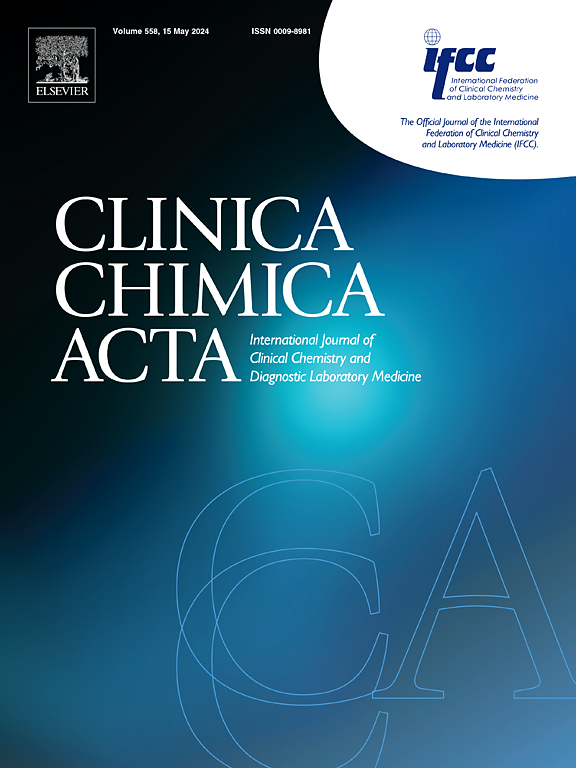MicroRNA-155 in neurodegeneration
IF 2.9
3区 医学
Q2 MEDICAL LABORATORY TECHNOLOGY
引用次数: 0
Abstract
MicroRNA-155 (miR-155) is recognized for its multifaceted roles in neuroinflammation and neurodegeneration. This abstract explores the emerging significance of miR-155, both as an intracellular regulator and encapsulated within exosomes, as a biomarker and therapeutic target in neurodegenerative disorders. Dysregulation of miR-155 is implicated in various conditions, including Alzheimer’s disease, Parkinson’s disease, and multiple sclerosis, where it modulates key pathways involved in neuronal survival, synaptic plasticity, and immune cell activation. Specifically, miR-155 has been shown to influence microglial activation, cytokine production, and the clearance of protein aggregates, all critical processes in neurodegenerative pathogenesis. Exosomal miR-155, released by various cell types including immune cells and neurons, offers a particularly exciting avenue. These nanovesicles facilitate intercellular communication, delivering their cargo, including miR-155, to recipient cells and influencing their function. As such, exosomal miR-155 levels in biofluids like cerebrospinal fluid and blood are being investigated as potential non-invasive diagnostic and prognostic biomarkers for neurodegenerative diseases. Furthermore, the ability of exosomes to cross the blood–brain barrier makes them attractive vehicles for targeted delivery of therapeutic agents. This review highlights the dual promise of miR-155 and exosomal miR-155: first, as readily measurable indicators of disease progression and response to treatment, and second, as actionable targets for novel therapeutic strategies aimed at modulating neuroinflammation and protecting neuronal integrity.
MicroRNA-155在神经变性中的作用。
MicroRNA-155 (miR-155)被认为在神经炎症和神经变性中具有多方面的作用。这篇摘要探讨了miR-155作为细胞内调节剂和外泌体内封装的新意义,作为神经退行性疾病的生物标志物和治疗靶点。miR-155的失调与多种疾病有关,包括阿尔茨海默病、帕金森病和多发性硬化症,在这些疾病中,miR-155调节涉及神经元存活、突触可塑性和免疫细胞激活的关键途径。具体来说,miR-155已被证明影响小胶质细胞的激活、细胞因子的产生和蛋白质聚集体的清除,这些都是神经退行性发病的关键过程。由包括免疫细胞和神经元在内的各种细胞类型释放的外泌体miR-155提供了一个特别令人兴奋的途径。这些纳米囊泡促进细胞间通信,将包括miR-155在内的货物运送到受体细胞并影响其功能。因此,生物体液(如脑脊液和血液)中的外泌体miR-155水平正在被研究作为神经退行性疾病的潜在非侵入性诊断和预后生物标志物。此外,外泌体跨越血脑屏障的能力使它们成为靶向递送治疗剂的有吸引力的载体。这篇综述强调了miR-155和外泌体miR-155的双重前景:首先,作为疾病进展和治疗反应的易于测量的指标,其次,作为旨在调节神经炎症和保护神经元完整性的新治疗策略的可操作靶点。
本文章由计算机程序翻译,如有差异,请以英文原文为准。
求助全文
约1分钟内获得全文
求助全文
来源期刊

Clinica Chimica Acta
医学-医学实验技术
CiteScore
10.10
自引率
2.00%
发文量
1268
审稿时长
23 days
期刊介绍:
The Official Journal of the International Federation of Clinical Chemistry and Laboratory Medicine (IFCC)
Clinica Chimica Acta is a high-quality journal which publishes original Research Communications in the field of clinical chemistry and laboratory medicine, defined as the diagnostic application of chemistry, biochemistry, immunochemistry, biochemical aspects of hematology, toxicology, and molecular biology to the study of human disease in body fluids and cells.
The objective of the journal is to publish novel information leading to a better understanding of biological mechanisms of human diseases, their prevention, diagnosis, and patient management. Reports of an applied clinical character are also welcome. Papers concerned with normal metabolic processes or with constituents of normal cells or body fluids, such as reports of experimental or clinical studies in animals, are only considered when they are clearly and directly relevant to human disease. Evaluation of commercial products have a low priority for publication, unless they are novel or represent a technological breakthrough. Studies dealing with effects of drugs and natural products and studies dealing with the redox status in various diseases are not within the journal''s scope. Development and evaluation of novel analytical methodologies where applicable to diagnostic clinical chemistry and laboratory medicine, including point-of-care testing, and topics on laboratory management and informatics will also be considered. Studies focused on emerging diagnostic technologies and (big) data analysis procedures including digitalization, mobile Health, and artificial Intelligence applied to Laboratory Medicine are also of interest.
 求助内容:
求助内容: 应助结果提醒方式:
应助结果提醒方式:


